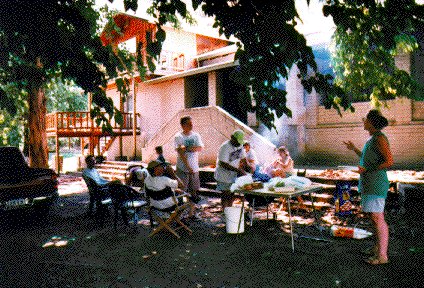

Mention Aravaipa to an Arizonan and you will immediately have their undivided attention. So, back in July when Peter Unmack said he was organizing an NANFA outing to Aravaipa Creek, I signed up without hesitation.
Aravaipa Canyon is one of the prettiest spots in Arizona. It is a limited access wilderness area managed by the US Bureau of Land Management and the Nature Conservancy. It is located approximately 45 miles south of Globe in the heart of Arizona's copper mining territory. The drive alone is worth the trip - mountain vistas, saguaro forests, and riparian areas.
Although we would not be in the Canyon itself, our native fish experience was just one mile from the entrance to the Canyon on private land owned by ASU Ullman Professor of Biology Philip Hedrick and his wife Kathy.
 Our
group consisted of Peter Unmack and Mike Baltzly (the pros), Phil (our host), Barbara
Terkanian, Ray Cone, Rhonda Wilson, myself (the novices), and my wife and daughter (Kate
& Emily -the tourists).
Our
group consisted of Peter Unmack and Mike Baltzly (the pros), Phil (our host), Barbara
Terkanian, Ray Cone, Rhonda Wilson, myself (the novices), and my wife and daughter (Kate
& Emily -the tourists).
Peter and Mike provided all the equipment, permits and expertise. Shortly after gathering at Phil and Kathy's place, we headed for the creek. Aravaipa Creek is one of the few year-round desert streams in Arizona. As such, it is a wonderful place to come see some of Arizona's native fish. Indeed, it is the only place in Arizona where it is possible to see seven native species in one place! We saw all but the speckled dace (Rhinichthys osculus).
Most of us had no previous experience seining and any preconceptions were immediately shattered. Seining (at least with Peter) is an aerobic experience. We learned two basic methods, what I like to call the "shovel" and the "stampede."
 In the 'shovel' method, two people pick a likely spot to
start. The net is stretched across the stream. The bottom of the net is flipped back, and
then with the poles extended in front, you charge down the stream keeping the bottom of
the net as close to the creek bed as possible. Peter said the object was to move faster
than the current. Sounds easy enough, but slippery rocks, unseen holes, overhanging
branches often prove difficult to negotiate. Falling down is a distinct possibility. Of
course, Peter encouraged us to lift the net up if we thought we were falling. Can't be
loosing any fish!
In the 'shovel' method, two people pick a likely spot to
start. The net is stretched across the stream. The bottom of the net is flipped back, and
then with the poles extended in front, you charge down the stream keeping the bottom of
the net as close to the creek bed as possible. Peter said the object was to move faster
than the current. Sounds easy enough, but slippery rocks, unseen holes, overhanging
branches often prove difficult to negotiate. Falling down is a distinct possibility. Of
course, Peter encouraged us to lift the net up if we thought we were falling. Can't be
loosing any fish!
The "stampede" method is quite exciting (both to watch and participate in). In this case, two people manage a stationary net at a downstream position. The rest of the group lines up upstream. All at once they come stomping down the stream, splashing, flipping rocks and generally creating a ruckus! Kate said it reminded her of a 'rabbit run' without the drums.
 Native
fishes netted included the Sonoran sucker (Catostomus insignis), desert sucker (Pantosteus
clarki), roundtail chub (Gila robusta), longfin dace (Agosia chrysogaster),
loach minnow (Tiaroga cobitis), and spikedace (Meda fulgida). The Sonoran
suckers were the most abundant fish we encountered, and also the largest (several around
10 inches). My favorites are the loach minnow and the spikedace. Non-native species
include yellow bullheads (Ameiurus natalis), red shiners (Cyprinella lutrensis)
and gambusia (Gambusia affinis).
Native
fishes netted included the Sonoran sucker (Catostomus insignis), desert sucker (Pantosteus
clarki), roundtail chub (Gila robusta), longfin dace (Agosia chrysogaster),
loach minnow (Tiaroga cobitis), and spikedace (Meda fulgida). The Sonoran
suckers were the most abundant fish we encountered, and also the largest (several around
10 inches). My favorites are the loach minnow and the spikedace. Non-native species
include yellow bullheads (Ameiurus natalis), red shiners (Cyprinella lutrensis)
and gambusia (Gambusia affinis).
A small piece of caudal fin was clipped from 25 suckers and chubs and placed in vials of alcohol. These fin clips were for Dr Michael Douglas (ASU Department of Biology) who is undertaking population genetic work on roundtail chubs and Sonoran suckers using mitochondrial and nuclear DNA. The information is being collected to help understand population structure and perhaps identify unique populations.
What more could you ask for? Spending time in a beautiful setting with interesting people doing important work. I'm sure we all would go back without hesitation. Our thanks to Peter for organizing this trip. A special "thank you" to Philip and Kathy Hedrick for their hospitality and assistance.